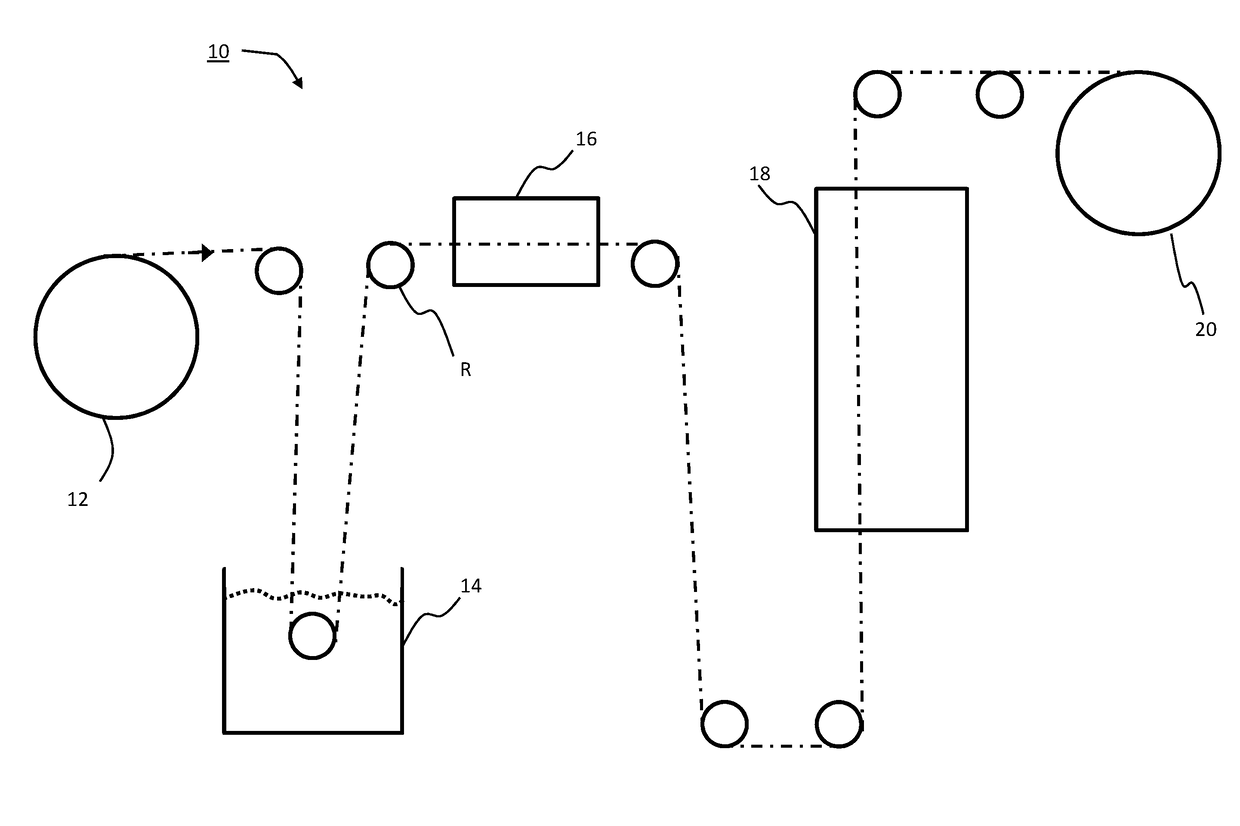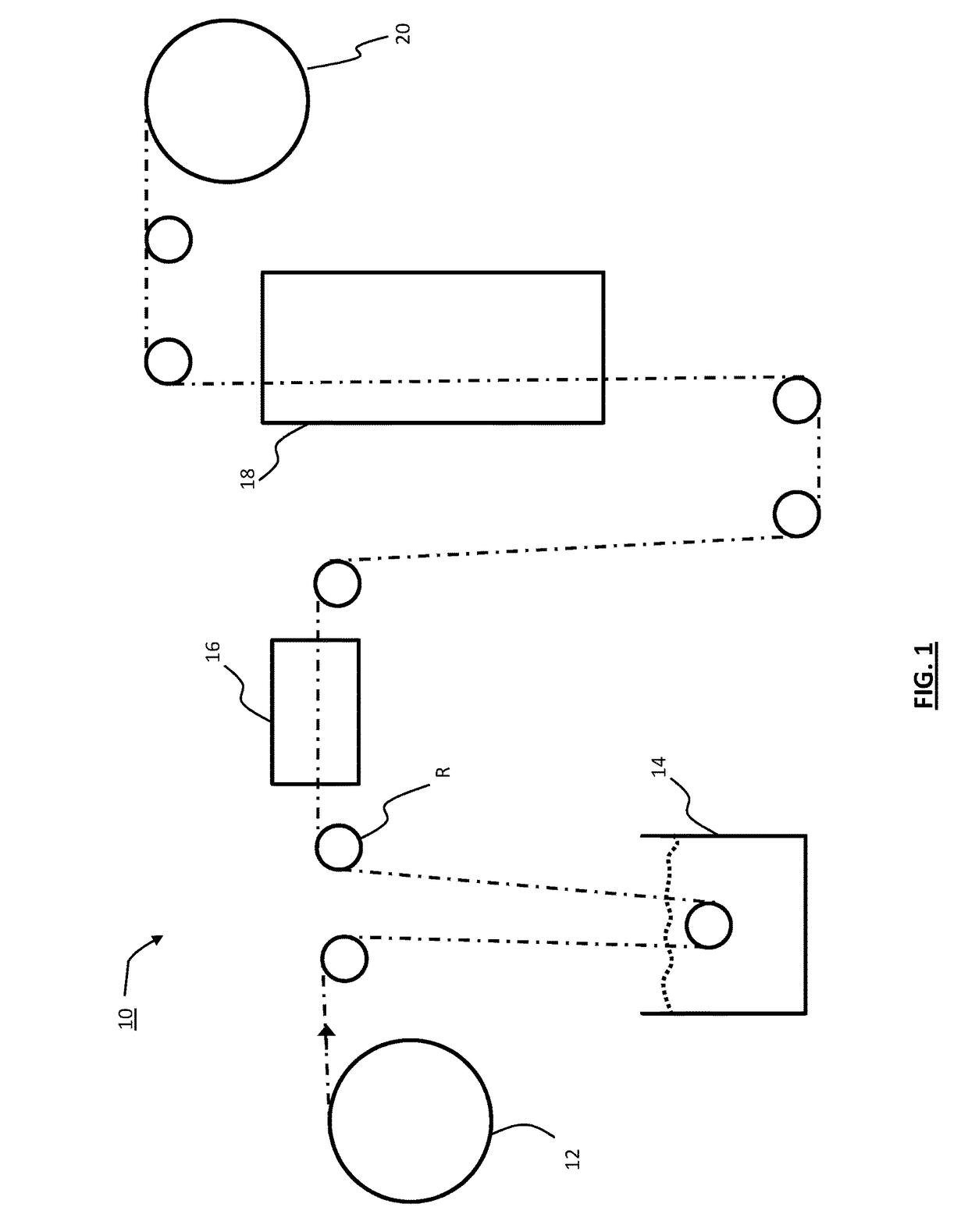Systems and methods for water repellent treatment of protective fabrics, and protective fabrics made using same
a technology for protective fabrics and textiles, applied in the field of fabrics water repellent treatment, can solve problems such as large and complex equipmen
- Summary
- Abstract
- Description
- Claims
- Application Information
AI Technical Summary
Benefits of technology
Problems solved by technology
Method used
Image
Examples
experiment # 1
Experiment #1
[0033]The first round of trials were set up to test the use of an IR heating module using two common types of fabric: FABRIC A (Twaron 550 DTEX 28×28) and FABRIC B (Twaron 930 dtex 27×27). Scoured fabrics were dried using standard drying techniques. A water repellent compound was then applied to the fabrics using a dip tank and conventional padder system. An IR heating module was used for curing and heat setting of the of the water repellent compound.
[0034]The IR module was alternatively set at low and high temperature settings, and was operated at a speed of 3 meters per minute). Note that it may be possible for the speeds to be varied (in some cases varied greatly), for instance by using additional heaters 18 and / or heating elements.
[0035]In the absence of a reference gauge for performance of the IR heating effects, a two-pass curing run was set up for the low temperature set-up, and a one-pass curing run for the high temperature set-up.
[0036]In general, the heaters w...
experiment # 2
Experiment #2
[0043]For a second round of trials, the use of an IR heating module for curing was examined in combination with the use of a vacuum module (having vacuum slots) for fluoropolymer impregnation. Table 3 below summarizes the results:
TABLE 3IR heater and Vacuum Module Investigation Results9 mmWR applicationTenter-V50 atTrialsPaddervacuumIRframe29LSubmersionStiffnessFABRIC A one pass,ONOFFON,OFF42827%0.6 Padder applicationonepassFABRIC A twoONOFFON,OFF43527%0.87passes, PaddertwoapplicationpassesFABRIC A one pass,OFFONOFFON43531%—vacuum applicationand tenter-framecureFABRIC A twoOFFONON,OFF45121%0.77passes, vacuumtwoapplication and IRpassescure
[0044]These trials demonstrate that the combination of a vacuum module for fluoropolymer impregnation and an IR heater module for curing proved to result in the highest performance. More particularly, water repellency treatment in most cases tends to deteriorate the 9 mm ballistic performance but in this case the combination of the vacu...
experiment # 3
Experiment #3
[0045]For this third round of trials, the combination of a vacuum module an IR heater was further explored. Table 4 below summarizes the results:
TABLE 4Further Exploration of IR and Vacuum CombinationWR application9 mmTrialspaddervacuumIRTenterframeSubmersionV50StiffnessFABRIC A two passes,OFFON passONOFF34%4380.65vacuum application andone onlyIR cureFABRIC A two passes,OFFON bothONOFF25%4410.83vacuum application andpassesIR cureFABRIC A one pass,OFFONOFFON26%4320.55vacuum application andtenter cure
[0046]Results from the third set of trials are in agreement with the previous trial, demonstrating the performance advantages in both water repellency and 9 mm ballistic performance when a two-pass technique uses the vacuum module during both passes for chemical impregnation, and an IR heater is used for curing.
[0047]In addition this technique appears to be particularly effective for three dimensional fabric structures. Specifically, penetration of the fluoropolymer into the ...
PUM
| Property | Measurement | Unit |
|---|---|---|
| temperature | aaaaa | aaaaa |
| temperature | aaaaa | aaaaa |
| temperature | aaaaa | aaaaa |
Abstract
Description
Claims
Application Information
 Login to view more
Login to view more - R&D Engineer
- R&D Manager
- IP Professional
- Industry Leading Data Capabilities
- Powerful AI technology
- Patent DNA Extraction
Browse by: Latest US Patents, China's latest patents, Technical Efficacy Thesaurus, Application Domain, Technology Topic.
© 2024 PatSnap. All rights reserved.Legal|Privacy policy|Modern Slavery Act Transparency Statement|Sitemap


